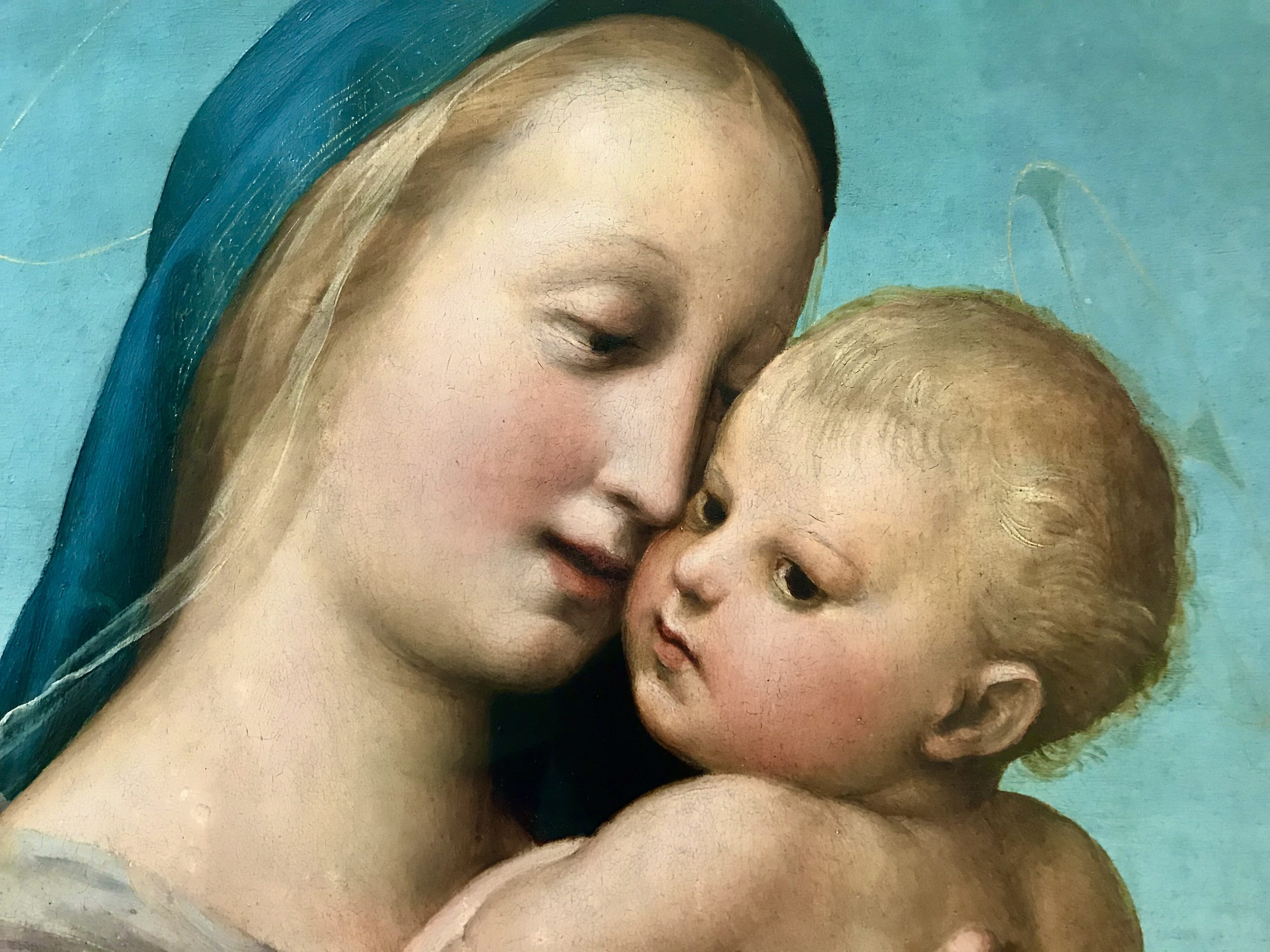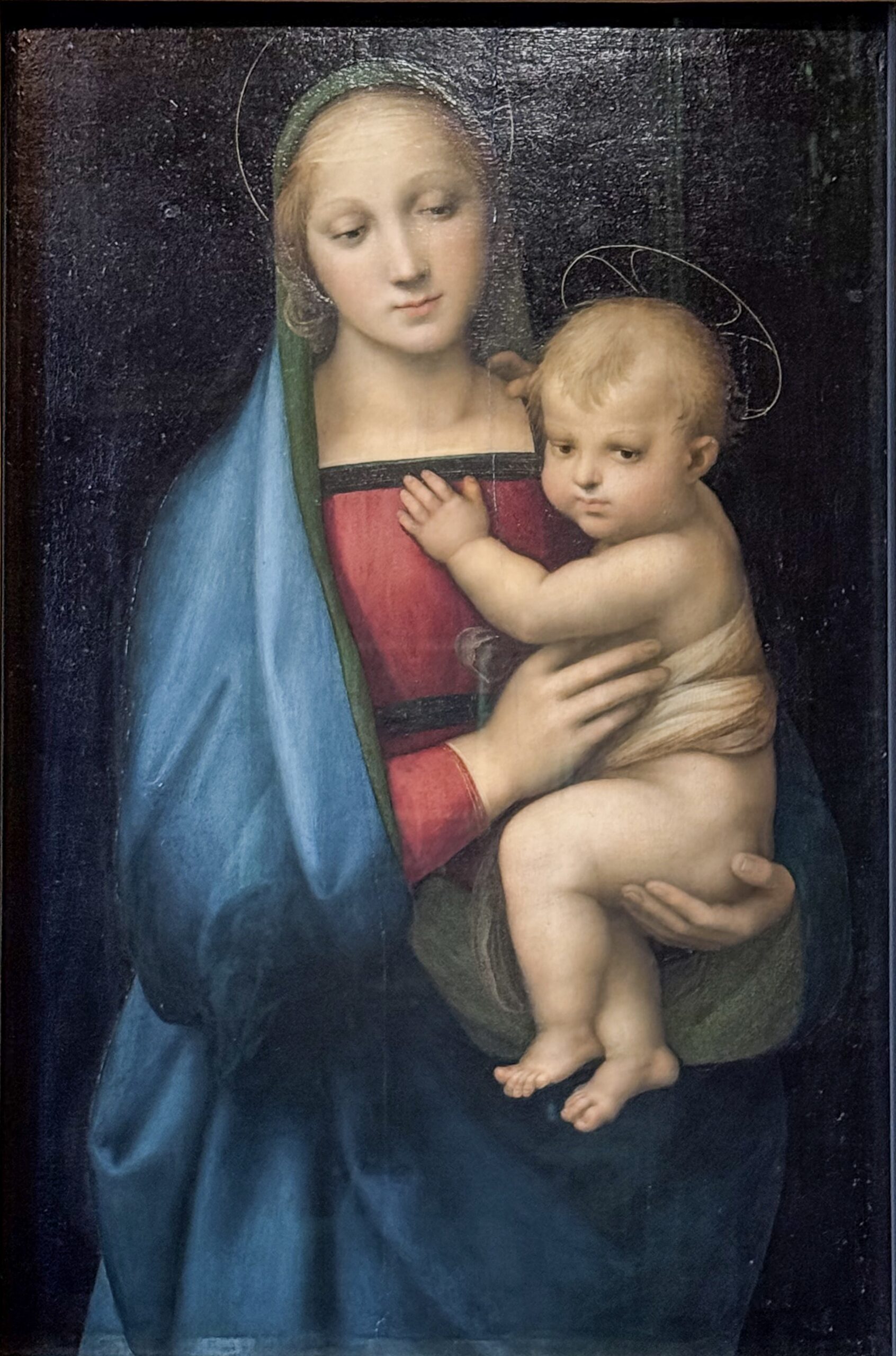Florenz, Raffael, Madonnen: Madonna del Granduca, 1505/06, Öl auf Holz, 84 x 55 cm, Palazzo Pitti
Raffaels große Karriere startet mit einer Reihe florentinIscher Madonnenbilder. Hier tritt Maria, nachdenklich nach unten blickend, als Dreiviertelfigur aus dem Dunkel. Leonardos Einfluss ist zu spüren. Leicht hält sie in natürlicher Weise ihr Kind, das den Betrachter aufmerksam ansieht.
Raphael’s great career began with a series of Florentine Madonna paintings. Here, Mary, looking down thoughtfully, emerges from the darkness as a three-quarter figure. Leonardo’s influence is evident. She holds her child lightly and naturally, who looks attentively at the viewer.
Ein Münchner Juwel als Gast

Ein Seitenblick auf ein Detail von Raffaels Madonna Tempi, um 1507, Öl auf Pappelholz, 75,3 x 51,6 cm, München, Alte Pinakothek. Das Bild ist mir bereits seit den 1950er Jahren vertraut, als die Eltern es uns Kindern zeigten.
Das Jesuskind blickt mit kindlichem Ernst zum Betrachter. Wange an Wange ist Maria mit ihm eins. Sie ist ganz beglückte mütterliche Empfindung. In dieser Gestalt gewordenen Mutterliebe in innigster Vertrautheit übertrifft Raffael alle Vorgänger. Er entzückt vor allem das 19. Jahrhundert. Das Göttliche der Gestalten beruht auf einer großartigen Fähigkeit: es gelingt ihm das Menschliche in überhöhender Schönheit des Natürlichen auf scheinbar leichte Weise darzustellen.
I have been familiar with Raphael’s Madonna Tempi since the 1950s, when my parents showed it to us children..
The baby Jesus gazes at the viewer with childlike seriousness. Cheek to cheek, Mary is one with him. She is filled with blissful maternal emotion. In this embodiment of maternal love, Raphael surpasses all his predecessors. He delighted the 19th century in particular. The divinity of the figures is based on a magnificent ability: he succeeds in depicting the human in the elevated beauty of the natural in a seemingly effortless manner.
Florenz, Raffael, Madonnen: vgl. Gemälde in Wien und im Louvre

Raffael, Madonna del Cardellino, 1506/07, Öl auf Holz, 107 x 77 cm, Florenz, Uffizien
Mit den geschwisterlichen Bildern der Madonna im Grünen in Wien und der Belle Jardinière, der Schönen Gärtnerin, im Louvre, bildet dieses Gemälde ein Dreigestirn ganzfiguriger Madonnen in natürlichen, zum Hintergrund sich aufhellenden Landschaften. Die Kinder begegnen sich als ruhige Spielgenossen. Nichts deutet auf künftiges Geschehen hin. Für Raffael und die Gläubigen genügt dafür der ruhige Blick und die unterbrochene Lektüre der schönen Mutter. Es braucht nicht einmal das sonst übliche dünne Rohrkreuz des Johannes.
Together with the sister paintings Madonna in the Green in Vienna and Belle Jardinière, the Beautiful Gardener, in the Louvre, this painting forms a triumvirate of full-length Madonnas in natural landscapes that lighten toward the background. The children meet as calm playmates. Nothing hints at future events. For Raphael and the faithful, the serene gaze and interrupted reading of the beautiful mother are sufficient. There is no need for the thin cane cross of John, which is otherwise customary.

Der klassische Farbakkord von dunklem Rot und tiefem Blau hellt sich im Licht wie bei der Madonna del Granduca zu strahlender Intensität auf.
The classic color combination of dark red and deep blue brightens in the light, as in the Madonna del Granduca, to a radiant intensity.

Der kleine Johannes, dessen Fellumhang auf sein künftiges Leben in der Wüste hinweist, reicht dem Jesuskind behutsam einen Stieglitz.
Little John, whose fur cloak hints at his future life in the desert, gently hands the baby Jesus a goldfinch.
Florenz, Raffael, Madonnen: ein besonders nahbares Andachtsbild

Raffael, Madonna della Sedia, 1513/14, Öl auf Holz, Durchmesser 71 cm, Florenz, Palazzo Pitti
Das Rundbild ist eines der in Rom entstandenen Hauptwerke Raffaels. Als privates Andachtsbild, dessen Auftraggeber unbekannt ist, entsteht es in zeitlicher Nähe zur Sixtinischen Madonna. Die Einfügung der Figuren in die Bildform, die Pracht der Kleidung und Farben und die intensiven Blicke der drei machen das Gemälde zu einem Lieblingswerk des Publikums weltweit.
The circular painting is one of Raphael’s major works created in Rome. Commissioned by an unknown patron as a private devotional image, it was created around the same time as the Sistine Madonna. The placement of the figures in the picture, the splendor of their clothing and colors, and the intense gazes of the three make the painting a favorite of audiences worldwide.
